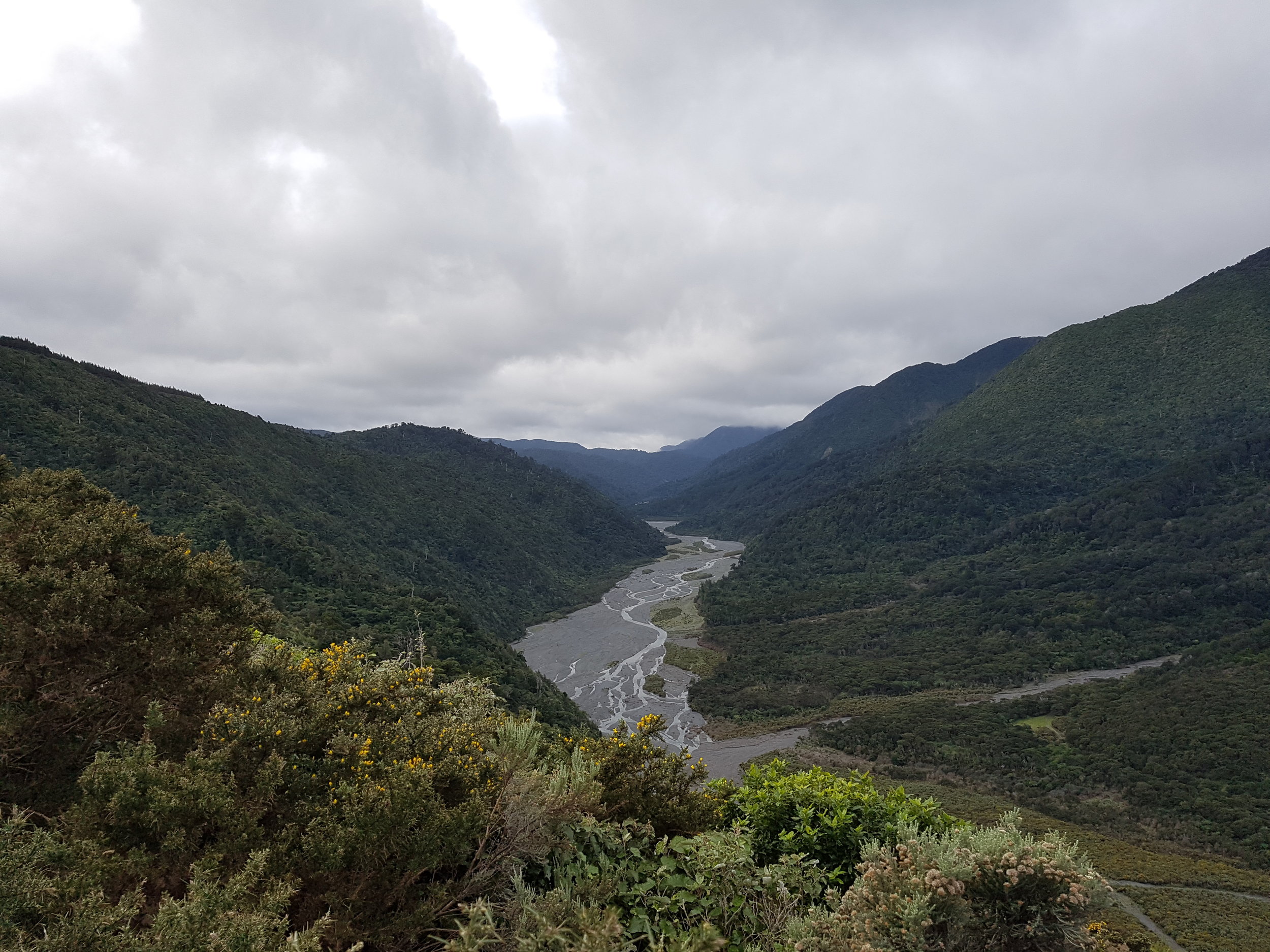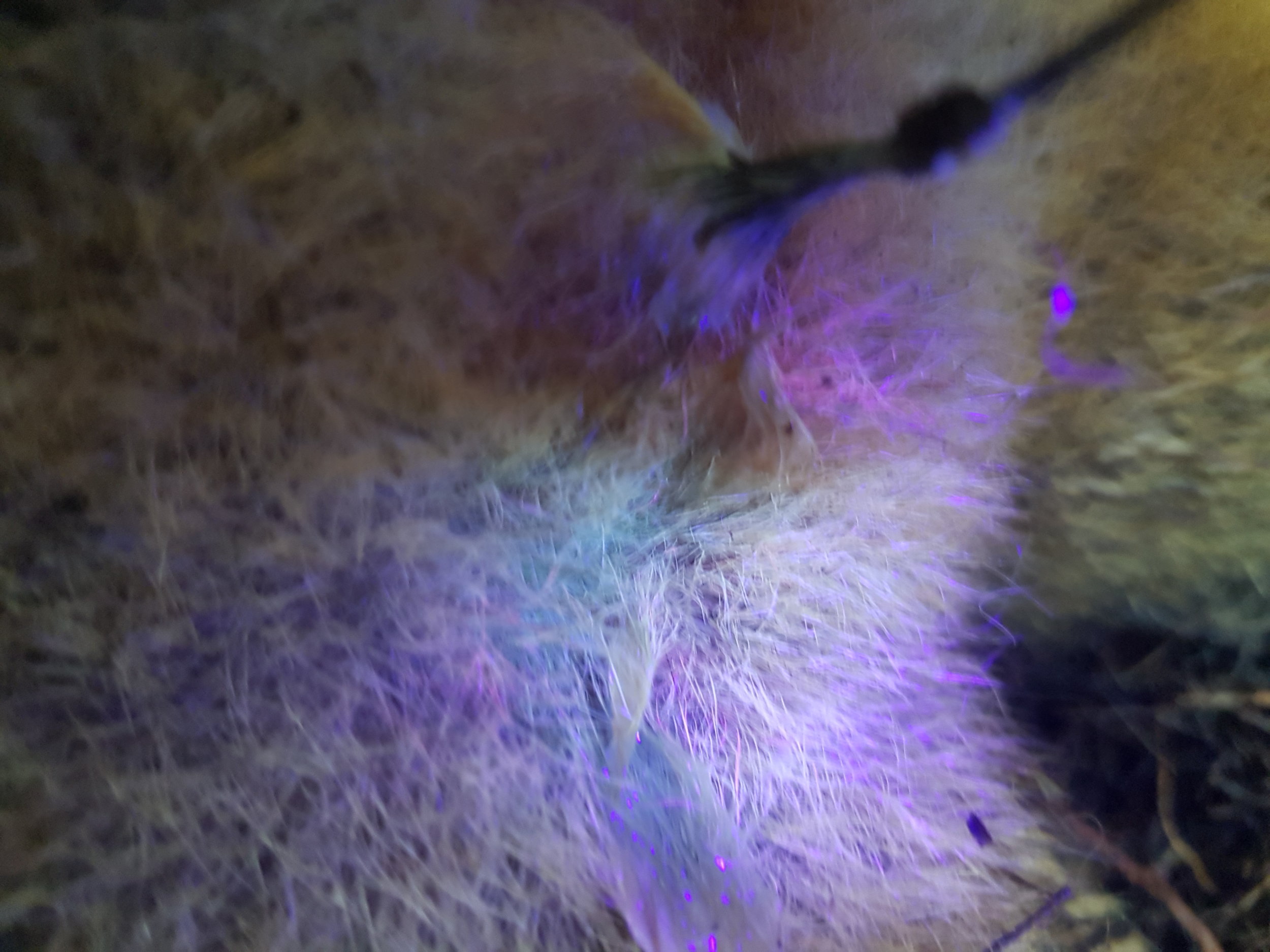Biomarkers can be a useful tool for measuring bait uptake, and animal movement. Pyranine is a non-toxic, short lived, fluorescent green biomarker that stains the intestinal tract of an animal, and is highly visible under UV light.
As part of a trial in 2017 aimed at assessing rivers as natural barriers to possum movement, Zero Invasive Predators (ZIP) used aerially sown and ground laid non-toxic pyranine laced cereal pellet baits to mark a possum population in the Orongorongo Valley, Remutaka Forest Park. The baits were sown weekly (weather permitting) on the true right side of the Orongorongo River, and leghold traps were deployed on the true left side (which had a low possum density due to pest control operations) to catch any marked animals that crossed the river. Trapped animals were then dissected and examined for traces of pyranine consumption to assess their origin.
Figure 1: Trial site – the Orongorongo Valley
Figure 2: Non-toxic pyranine-laced cereal pellet baits under day light (L) and UV light (R)
Possums were also trapped uphill from the pyranine sowing zone on the true right side of the river to confirm marking and assess possum movement over land for the duration of the trial. A total of 82 possums were caught in kill traps on this trap line that displayed obvious signs of pyranine consumption in the stomach, intestines and rectal tract.
Figure 3: (L) Possum showing vibrant green fluorescence in the intestinal tract due to significant consumption of pyranine pellet baits in the sowing zone on the true right;
(R) possum scats in the same area showing obvious pyranine staining
A total of 44 possums were caught along the true left side of the river, two of which were observed by fIeld staff to have faint green fluorescence under UV light on several external areas of the possums’ bodies. No pyranine traces were found internally in either possum. This surprising observation was the catalyst for pyranine feeding trials at the ZIP Predator Behaviour Facility at Lincoln, Christchurch, which aimed to (i) accurately quantify pyranine expression in possums both internally and externally, and (ii) identify the presence of any naturally occurring fluorescence on the possums themselves.
Figure 4: Two possums caught on the true left side of the Orongorongo River displayed green fluorescence under UV light on wrists, guard hairs, the urogenital area and around the snout, but no internal traces of pyranine staining
Pyranine Possum Trials at the ZIP Predator Behaviour Facility
September–November 2017
Trials investigating possums for both external and internal fluorescence were carried out, comparing control possums to those who were fed non-toxic pyranine laced cereal pellet baits. Table 1 below shows the reduction of the internal pyranine detectability from 2 to 6 days after consuming 5 baits (n = 3 possums).
Table 1: Pyranine reduction in detectability over time
Figure 5: Fluorescent green scats, urine and anus of a possum two days after being fed 5 pyranine laced baits at the ZIP Animal Behaviour Facility, Lincoln
When several control possums were examined externally, natural green fluorescence was discovered in the wrist fur, paw pads, whiskers and urine! The urine especially could easily contaminate fur around the urogenital area and other parts of the body, providing a likely explanation for some of the faint green markings on the two ‘surprise’ possums in the Orongorongo Valley.
Figure 6: Natural fluorescence of wrist fur, paw pads and urine on a control possum at the ZIP Animal Behaviour Facility, Lincoln
Orongorongo Valley Trial Conclusions
As a result of these trials, ZIP was able to ascertain that the two ‘surprise’ possums in the Orongorongo Valley did not contain traces of pyranine. This meant that no marked possums were caught on the true left side of the river for the duration of the original field trial, indicating that the river was acting as a barrier to possum movement.
Conclusions for use of Pyranine Biomarker in Possums
Possum urine is naturally fluorescent green under UV light, so is not a reliable indicator of pyranine presence
Natural green fluorescence under UV light can occur in wrist fur, paw pads, guard hairs, whiskers and some individual tail hairs
Therefore external examination alone cannot be relied upon to give accurate results
Pyranine moves quickly through a possum’s internal digestive system, metabolising out within a matter of days
The ability to reliably detect consumed pyranine internally runs out around 4 days after consumption
All animals retrieved in the field during a pyranine experiment should be subjected to internal sampling as the primary method for assessing pyranine marking

















